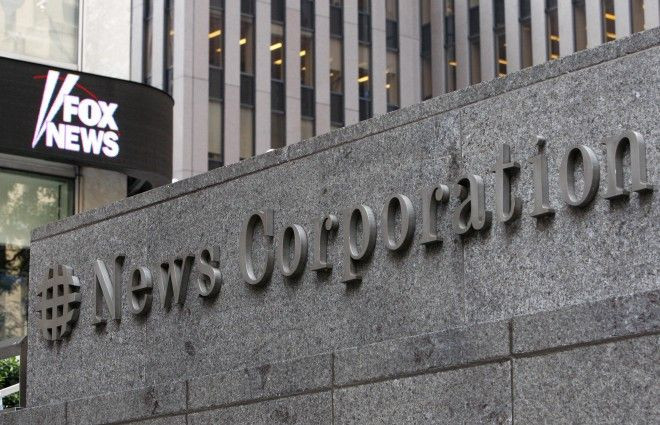News Corp. Earnings Preview: Higher Profits And No Separation Anxiety

News Corporation (Nasdaq:NWSA) is expected to report higher first-quarter fiscal year 2013 profits Tuesday, as a boom in political ad spending on the unbeatable Fox News helped bring double-digit earnings growth for its cable unit, offsetting a double-digit decline in newspaper profits for the period ending Sept. 30.
With a market capitalization of $57.43 billion, News Corp. is expected to report first-quarter EPS of 38 cents, up from 32 cents for the year-earlier period. Analysts polled by Thomson Reuters expect the New York-based media group to report first-quarter net income of $901 million, up from $823 million last year. The company’s total first-quarter revenue is expected to be $8.1 billion, up 2.6 percent from $7.9 billion last year.
Like most big-media companies, News Corp. benefited from a boost in political ad spending on its television networks as the election season started up in early fall. Fox News, the country’s most-watched cable news network, consistently outpaced its rivals throughout the quarter. During the Republican National Convention, from Aug. 27 to Aug. 30, the network logged an 11 percent ratings increase over the convention of 2008. With revenue in the segment up an estimated 14 percent for the quarter, cable network programming is easily the biggest driver of News Corp.’s growth.
“Cable networks and television assets are expected together to account for 94 percent of total operating income growth in FY13,” wrote Vasily Karasyov, an analyst with Susquehanna International Group, in a research note. “We estimate that only 12 percent of the revenue increase in these two segments will come from U.S. advertising, with the remaining 88 percent driven by affiliate and [retransmission] revenue gains as well as continued international expansion.”
Stilted by a lack of hit movies, News Corp.’s filmed entertainment unit did not see a blockbuster in its fiscal first quarter. “Ice Age: Continental Drift,” released on July 13, was the only 20th Century Fox release to make it into the top 10 for 2012. Still, the animated family film took in a worldwide gross of $867.2 million.
Publishing continued to struggle in the July-through-September quarter, in particular News Corp.’s newspaper business. Alice Bennett, an analyst with Commonwealth Bank, expects the company to report a 25 percent decline in operating profit for its newspaper business, which includes the New York Post, the Community Newspaper Group and the Wall Street Journal, the most widely circulated newspaper in the United States. News Corp.’s much-hyped iPad-only newspaper, The Daily, introduced in 2011, has not worked out as planned. On July 31, the subscription-based publication laid off nearly a third of its 170 employees, with Murdoch admitting that subscription revenue has fallen short of what is needed to keep The Daily solvent.
Just before News Corp.’s fiscal first quarter began, Rupert Murdoch, chairman and CEO, ended brewing speculation about the company’s future by telling investors June 28 the conglomerate planned to separate its publishing business from its media and entertainment business. The separation, expected to be completed next year, will create two distinct publicly traded companies. Once it’s finalized, shareholders will hold interest in each company. Murdoch will serve as chairman of both companies and as the CEO of the media and entertainment company.
“We recognize that over the years, News Corporation’s broad collection of assets have become increasingly complex,” Murdoch said in a statement. “We determined that creating this new structure would simplify operations and greater align strategic priorities, enabling each company to better deliver on our commitments to consumers across the globe.”
The market agreed. Since the announcement, News Corp. shares rose steadily throughout its fiscal first quarter, hitting a near five-year high of just under $25 per share on Sept. 29. This was achieved despite an ongoing phone-hacking scandal surrounding the British tabloid News of the World, which continues to attract negative headlines. The company’s separation, however, is expected to rectify some of those issues by shielding News Corp.’s more successful entertainment and media business from mounting legal costs associated with the scandal. Perhaps the biggest aspect of the split, however, is what analysts see as Murdoch’s epiphany regarding the future of print publishing, an industry in which he had until now demonstrated a stubborn faith.
“While Rupert Murdoch remains a die-hard supporter of newspapers, we believe he has come to accept the realities of the modern-day publishing business,” wrote Richard Greenfield, an analyst with BTIG, in a research note. “Especially, given his increasing use of Twitter, where news and information is being condensed to 140 characters and is freely available to consumers all over the world.”
Despite these losses, as well as the general uncertainty of splitting the company into two businesses, analysts expect continued growth until the separation is complete next year. “We see further outperformance going forward,” wrote Bennett, “with the expected positive re-rating of the entertainment company likely to more than offset the negative re-rating of the publishing company.”
News Corp. shares have a mean recommendation of “overweight” according to 23 analysts, 19 of whom rated the stock “buy.”
The company reports Tuesday, Nov. 6, after the market closes. News Corp. shares closed Friday at $23.88.
© Copyright IBTimes 2025. All rights reserved.






















